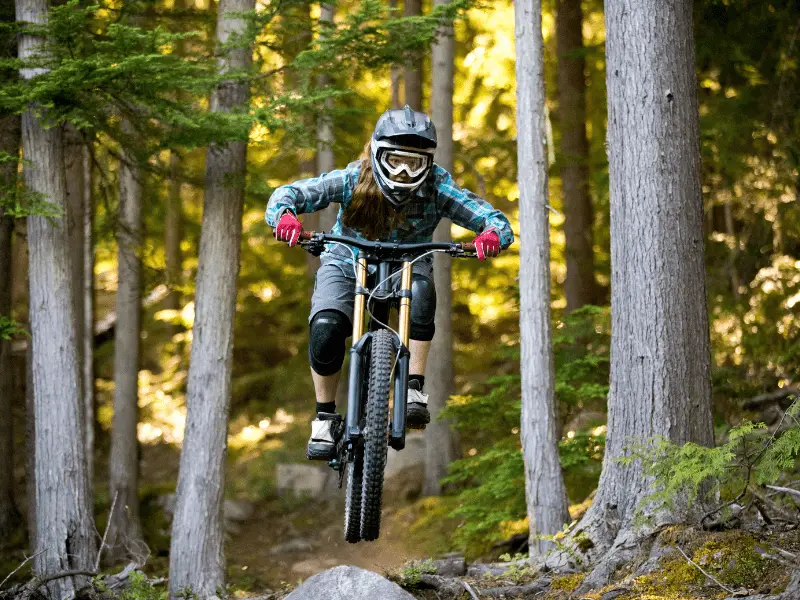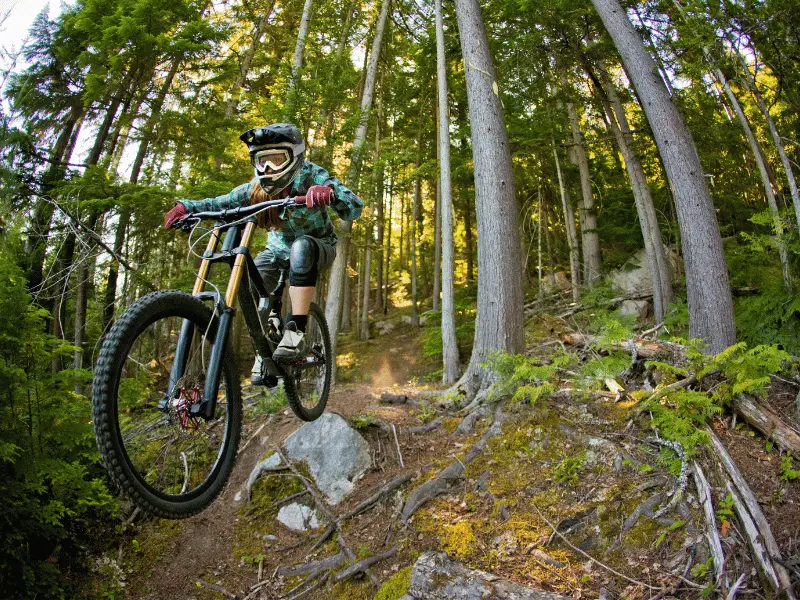
If you ride a mountain bike for thrills, you’ve probably pondered how quickly you can go down a steep hill. Due to the adrenaline rush that comes from descending a hillside quickly on two wheels, has been gaining popularity in recent years.
In this blog post, we’ll examine the world of downhill mountain biking and provide answers to some of the most frequently asked questions, including where you can go on this kind of adventure and what to wear to stay safe and comfortable. We’ll also discuss what downhill mountain biking is and what it involves.
We’ll start by discussing the basics of downhill mountain biking, including the equipment, terrain, and techniques involved. Then, we’ll delve into the question that’s on everyone’s mind: how fast can you go downhill on a mountain bike?
We’ll look at some of the factors that influence a rider’s speed, such as the gradient of the hill, the condition of the trail, and the rider’s skill level. We’ll also explore some of the world records and amazing achievements in downhill mountain biking, such as the fastest speed ever recorded on a bike.
If you’re interested in trying downhill mountain biking for yourself, we’ll share some tips on where to go and what to expect. Finally, we’ll cover the essential gear that you should wear for this intense activity, from the helmet and pads to the right shoes and clothing. So, if you’re ready to discover the thrill of downhill mountain biking and learn just how fast you can go, read on!
What is downhill mountain biking?
Downhill mountain biking, also known as DH, is a thrilling and fast-paced form of mountain biking that involves descending steep and rugged terrains at high speeds. The objective of the sport is to complete a downhill trail in the fastest possible time while negotiating obstacles such as rocks, jumps, and drops. Downhill mountain biking is an extreme sport that requires a high level of skill, technique, and physical fitness, as well as specialized equipment and protective gear.
There are several types of downhill mountain biking, including downhill racing, freeride, and bike park riding. Downhill racing is the most competitive and structured type of DH, where riders race against the clock on a timed course.
Freeride is a more creative and freestyle form of DH, where riders focus on executing tricks and stunts on natural or man-made features.
Bike park riding involves riding in a specially designed and maintained bike park, where riders can practice and improve their skills on a variety of trails and features.
Overall, downhill mountain biking is an exciting and challenging sport that offers a unique adrenaline rush and a sense of accomplishment. However, it is also a risky and potentially dangerous activity that requires proper training, equipment, and safety measures.
In the next sections of this blog post, we’ll explore the specifics of how fast a mountain bike can go downhill, what type of bike to use, where to go, and what gear to wear to stay safe and enjoy the sport to the fullest.
How fast can a mountain bike go downhill?

The speed at which a mountain bike can go downhill largely depends on several factors, including the terrain, weather conditions, bike components, and the skill level of the rider. However, experienced downhill riders can often reach speeds of up to 60 miles per hour or more.
For the average downhill rider, speeds of around 30-40 miles per hour are common on challenging terrain with steep descents, while less experienced riders may ride at slower speeds. The type of bike also plays a role in how fast a rider can go downhill.
Downhill bikes, which are specifically designed for the sport, generally have stronger brakes, suspension, and wider tires than standard mountain bikes, which can allow for faster and more stable descents.
If you’re looking to increase your speed on the downhill, there are a few tips that can help. Firstly, it’s important to have a good understanding of the terrain and the trail ahead of you, so that you can anticipate and prepare for changes in slope and obstacles.
Second, having the right equipment, such as a properly adjusted suspension, brakes, and tires, can make a significant difference in your speed and control. Finally, practice, practice, practice! The more experience and confidence you gain in your riding skills, the more likely you are to reach higher speeds and push your limits.
However, it’s important to keep in mind that downhill mountain biking can be dangerous and should be approached with caution and respect for the sport and the environment. In the next sections of this blog post, we’ll explore the different types of mountain bikes and where to go downhill biking, as well as the essential gear and clothing needed to stay safe and comfortable on the trail.
Where to go downhill mountain biking?
There are many great destinations around the world for downhill mountain biking, each with their own unique terrain, trails, and challenges. Here are some of the top locations to consider:
Whistler, British Columbia, Canada: Whistler is often considered the mecca of downhill mountain biking, with over 70 trails and a world-renowned bike park. The terrain ranges from beginner to advanced, and there are plenty of rental options and guides available.
Moab, Utah, USA: Moab is known for its challenging and technical terrain, with red rock formations and steep descents. The area offers a variety of trails, from beginner to advanced, as well as breathtaking scenery.
Bikeparks in your area: Many ski resorts have converted their slopes into bike parks during the summer months, offering a range of trails and features for downhill mountain biking. Check out your local area for bike parks and downhill mountain biking trails.
It’s important to research and plan your downhill mountain biking trip in advance, as well as to check local regulations and trail conditions. Make sure to choose trails that match your skill level and experience, and consider hiring a guide or taking lessons to improve your technique and safety on the trail.
What to wear for downhill mountain biking?
When it comes to downhill mountain biking, wearing the right gear is essential for both safety and comfort. Here are some of the most important items to consider:
- Helmet: A good quality helmet is an absolute must for downhill mountain biking. Look for a full-face helmet that provides maximum protection for your head and face, and make sure it fits well and is securely fastened.
- Body armor: In addition to a helmet, body armor can provide extra protection for your chest, back, and shoulders. Consider wearing a full-upper body armor suit or a separate chest protector and shoulder pads.
- Gloves: Gloves can help you maintain a good grip on your handlebars and protect your hands in case of a fall. Look for gloves with good padding and ventilation, and make sure they fit well.
- Goggles: Goggles can protect your eyes from dust, debris, and branches while also improving your visibility. Choose goggles with a clear lens for daytime riding and a tinted lens for low-light conditions.
- Clothing: Your clothing should be comfortable, breathable, and provide good range of motion. Look for technical fabrics that wick away moisture and dry quickly, and consider wearing long sleeves and pants to protect your skin from scrapes and cuts.
- Shoes: Your shoes should provide good traction on your pedals and the ground, and be comfortable for walking and riding. Look for mountain biking shoes with stiff soles and good grip, and consider shoes with ankle protection for added support.
- Knee and shin guards: Knee and shin guards can protect your lower legs from impacts and scrapes, and are especially important for technical downhill riding. Look for guards that are comfortable, breathable, and provide good range of motion.
It’s important to invest in high-quality gear and clothing that fits well and is appropriate for your skill level and the terrain you’ll be riding on. Don’t forget to also bring plenty of water, snacks, and sunscreen, and consider carrying a first aid kit and tools for emergency repairs.
By wearing the right gear and clothing, you can help ensure a safe and enjoyable downhill mountain biking experience.
Final Thoughts
As we’ve explored in this blog post, downhill mountain biking can be an exhilarating and challenging experience for riders of all skill levels. From the speed and adrenaline of descending steep hills to the technical challenges of navigating rocky terrain, downhill mountain biking offers a unique and exciting way to explore the great outdoors.
However, it’s important to approach downhill mountain biking with caution and the right mindset. By choosing the right gear and clothing, researching and planning your trip, and practicing good safety habits on the trail, you can help ensure a safe and enjoyable experience.
Whether you’re a seasoned rider or new to the sport, there are plenty of destinations around the world to explore for downhill mountain biking, from Whistler to Moab to local bike parks. So gear up, hit the trail, and experience the thrill of downhill mountain biking for yourself!
